introduction
This article refers to the address: http://
With the rapid development of economic income and the automobile industry, hidden dangers have followed. One of the main causes of traffic accidents caused by blurring of the car driver's vision during driving due to fogging of the windshield of the car. Today, many models have demisting gears. However, improper timing of the driver's use of the HVAC system can also cause a lot of energy consumption or accidents. It can be seen that intelligent defogging is not a guarantee of driving safety alone, and also saves energy consumption of the car. This paper analyzes the causes of fogging of automotive glass and selects appropriate sensors to realize intelligent detection of windshield fogging controllers.
1, detection principle
After the moisture in the atmosphere reaches saturation, water or mist is formed on the dust in the air, and the so-called fog is formed on the glass. This is because the air has a high dew point and the humidity in the air is cold. The solid forms a saturated state. It can be seen that the main cause of the fog formed on the windshield is the temperature of the windshield and the temperature of the air dew point in the cabin.
Based on this principle, we can monitor the temperature inside the cabin in real time through the MLX90614 sensor. The MLX90614 sensor is custom-designed by Melexis for space zone temperature sensing. The TO-39 package integrates an infrared sensitive thermopile detector chip and signal processing ASSP (Application Specific Integrated Circuit) chip. Thanks to the integrated low noise amplifier, 17-bit ADC and powerful DSP unit, high-precision thermometers are realized. It has the characteristics of small body and low cost. It has a wide range of factory calibration temperature. It can reach 0.5°C in the range of 0-50°C, single voltage 3V/5V, SMBUS/PWM interface, and the product grade meets the vehicle standard. Set to SMBus output with a resolution of 0.02 °C over the entire temperature measurement range.
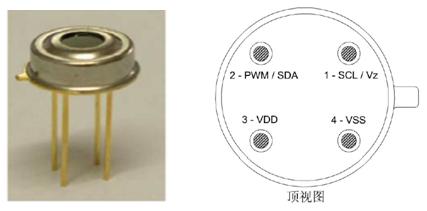
Figure 1. MLX90614 sensor

Figure 2. MLX90614 precision table
From the above analysis, the MLX90614 sensor can fully meet the requirements.
2, hardware circuit design
On the automotive glass intelligent anti-fog controller, the hardware circuit mainly includes the power supply LDO circuit, the main controller circuit, and the MLX90614 sensor detection circuit.
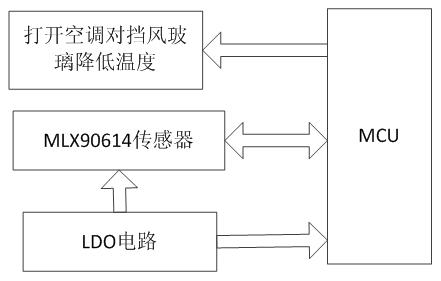
Figure 3. System block diagram
2.1, LDO circuit
In the automotive glass intelligent anti-fog controller, the voltage is reduced from 48V to 5V, and the dedicated LDO chip is used to achieve the desired voltage. In this scenario, we used the RN5RT33AATR chip to drop to 3.3V.
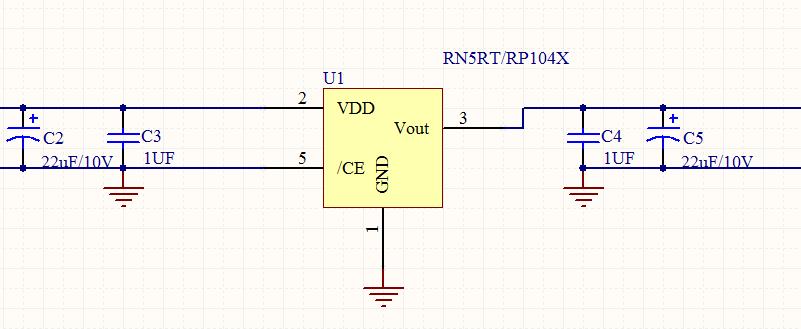
Figure 4. LDO filter circuit
2.2, MLX90614 sensor drive circuit
As the key device in this article, the MLX90614 sensor supports SMBUS and PWM interface modes. This article lists both methods. But we recommend the SMBUS method because it is compatible with the car interface.

Figure 5. PWM output drive circuit of MLX90614
The MLX90614 has a clamping diode that is connected between SDA/SCL and VDD to provide power to the MLX90614 device without the SMBUS line becoming a load.

Figure 6. SMbus output driver circuit for the MLX90614
After the EEPROM is configured for PWM, POR, the PWM mode is free running. For the PWM mode of operation, the SCL pin must be high.
2.3, MCU circuit design
In this scheme, we chose the Renesas MCU with high cost performance as the MCU, and its model is R5F101AG. The main controller mainly completes the drive and communication, data analysis and processing with the MLX90614.
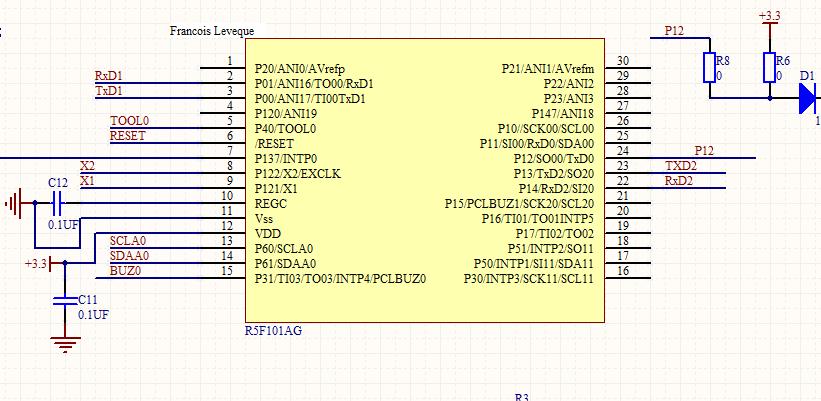
Figure 7. Master circuit
3, software design
In terms of software design, it mainly includes initialization, MLX90614 configuration, MLX90614 data reading and temperature calculation.
Void main()
{ uint Tem; // temperature variable uint Temh;
SCK=1;
SDA=1;
Delay(4);
SCK=0;
Delay(1000);
SCK=1;
Screen_initial();
While(1) {
Tem=readtemp(); //Read temperature
Display(Tem); //Show temperature
Temh=wreadtemp();
Displayw(Temh);
Delay(10000);
} }
4 Conclusion
The MLX90614 is a system-on-chip sensor for area temperature sensing applications. This chip is specifically designed for automotive applications and is also suitable for applications based on zone temperature sensing. The automotive glass intelligent anti-fog controller designed in this paper is a typical example.
The Co-Al Co-doped Barium Titanate
Lead-free Piezoelectric Ceramics was successfully developed by Yuhai company
through repeated experiments. By Researching the influence of Co-Al Co-doping
on the structure and properties of Barium Titanate-based piezoelectric
ceramics, the formulation and preparation technology of Barium Titanate-based
piezoelectric ceramics were optimized. Yuhai`s BaTiO3 was prepared by conventional
solid-phase sintering method, with the piezoelectric constant d33 (>170pC/N),
dielectric loss tgδ≤0.5% and mechanical coupling coefficient Kp≥0.34.
Barium titanate lead-free piezoelectric
ceramics are important basic materials for the development of modern science
and technology, which was widely used in the manufacture of ultrasonic
transducers, underwater acoustic transducers, electroacoustic transducers,
ceramic filters, ceramic transformers, ceramic frequency discriminators, high
voltage generators, infrared detectors, surface acoustic wave devices,
electro-optic devices, ignition and detonation devices, and piezoelectric
gyroscope and so on.
Application: military, ocean, fishery, scientific research,
mine detection, daily life and other fields.
China Patent of Yuhai company`s BaTiO3
Chinese Patent No.: ZL 2011 1
0126758.6
Name: Lead-free Barium Titanate
Piezoelectric Material with Addition of Cobalt and Aluminum
Lead free piezo material BaTiO3
Lead-free Material
Properties
BaTiO3
Dielectric Constant
ɛTr3
1260
Coupling factor
KP
0.34
K31
0.196
K33
0.43
Kt
0.32
Piezoelectric coefficient
d31
10-12m/v
-60
d33
10-12m/v
160
g31
10-3vm/n
-5.4
g33
10-3vm/n
14.3
Frequency coefficients
Np
3180
N1
2280
N3
Nt
2675
Elastic compliance coefficient
Se11
10-12m2/n
8.4
Machanical quality factor
Qm
1200
Dielectric loss factor
Tg δ
%
0.5
Density
Ï
g/cm3
5.6
Curie Temperature
Tc
°C
115
Young's modulus
YE11
<109N/m3
119
Poison Ratio
0.33
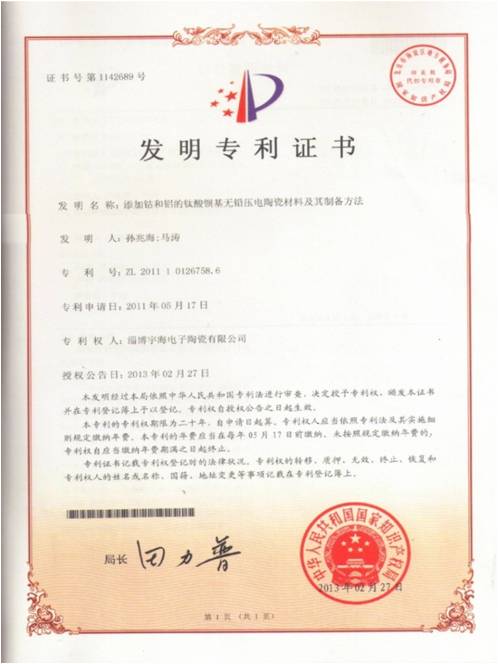
Lead Free Piezoelectric Elements
Piezo Element,Piezo Ceramic Elements,Piezoelectric Ceramic,Pzt Tubes
Zibo Yuhai Electronic Ceramic Co., Ltd. , https://www.yhpiezo.com